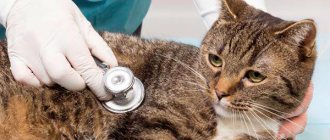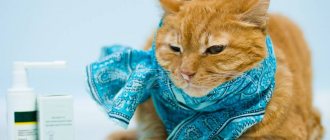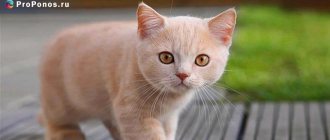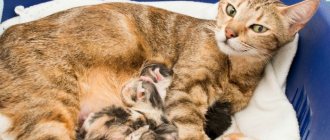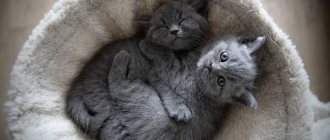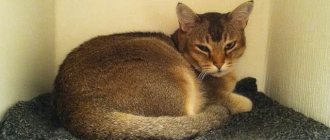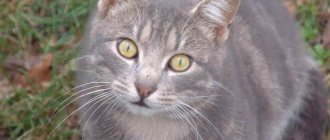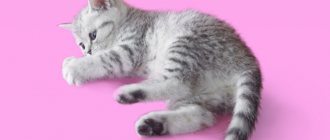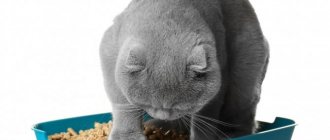A kitten in the house is not only a joy for all family members, but also a great responsibility. Kittens are like little children, so they need constant care, attention, affection, and love. Any changes in the behavior or condition of a furry pet should alert the caring owner.
The baby's body reacts sharply to any adverse factors affecting the animal's body. For example, unlike adult cats, kittens are much more likely to have diarrhea. Diarrhea in a 2-month-old kitten, which occurs for a variety of reasons, is a symptom of serious systemic pathologies, diseases, and infections. Therefore, do not ignore intestinal upset. Let's look at what to do if a kitten is diarrhea and how to stop diarrhea at home.
Symptoms of diarrhea in kittens
global $ads_google; //data-ad-slot=”2475549904″ $ads_google = empty($ads_google) ? false : true; ?> if ($ads_google == false) {?>
$ads_google = true; ?> } ?>
It is not difficult to determine that a kitten has diarrhea. This is necessary in order to take health measures in a timely manner and prevent serious consequences for the life of the young cat.
So, we determine loose stools in kittens:
- the kitten’s state can easily be considered depressed;
- there are problems with appetite, more often it simply doesn’t exist;
- if diarrhea is prolonged, the animal’s weight will decrease;
- frequent bowel movements;
- dehydration (when taken by the scruff of the neck, the skin then straightens out for a long time);
- loose stools, possible admixtures of undigested food;
- your tummy may be bloated.
In general, it is clear from the baby that he is experiencing discomfort, so it is important to find out what could cause such a disruption of the gastrointestinal tract.
Why does my kitten have diarrhea?
Keeping a pet is a big responsibility, as the pet needs care and can get sick. Absolutely all cat owners experience diarrhea in their cats, but usually this “disease” goes away without intervention. When the question concerns kittens, owners are more wary, because this is a child, he is weak and may die. The iron rule - do not feed if there is diarrhea, seems inhumane to the owner... and is violated.
Let's start with the fact that diarrhea is not a harmless ailment, but most often a symptom of a serious disorder. Adult animals can actually cope with this condition on their own, but kittens are under great threat. The devastating consequence of diarrhea is dehydration, which occurs much faster in kittens.
Why is it important to determine the cause of the disease? Diarrhea can be a symptom of various conditions, and treating the symptoms is pointless; the cause must be eradicated. If a kitten suffers from a viral or infectious disease that has already affected the digestive system and caused diarrhea, complex therapy cannot be avoided.
Main causes of diarrhea
Diarrhea is the rapid passage of food through the digestive tract. There are quite a few reasons for this phenomenon:
- animal experience;
- nutritional errors;
- infection;
- parasites;
- allergy;
- fur accumulated in the stomach;
- sickness and poor health.
Let's look at each reason in more detail.
The emotional state of a small animal can tell on its digestion. This may be a reaction to a change of place of residence, the appearance of a new inhabitant or guest in the apartment, and especially gentle cats even react to a change in the tray and sleeping place that has become familiar.
Errors in diet planning definitely cause damage to health. Most often, owners worry about their pet and desperately overfeed it, especially by abusing cat treats. This also includes the kitten eating prohibited foods, such as smoked meats, spoiled food, or changing food.
Infections in the form of panleukopenia, coronavirus enteritis, toxoplasmosis and calicivirus can easily overcome a baby. But the stool will not tell you what exactly is to blame here; if an illness is suspected, the kitten is taken to the veterinarian.
The appearance of parasites in the body is also not uncommon. They can be brought in by people with food and land. Gradually there will be more and more of them, and the kitten will develop diarrhea as a reaction to intoxication of the body. Tape tapeworm and coccidia are especially guilty.
Allergies are also considered among the probable causes of loose stools. It could be your own fur or other irritants; it makes sense to visit a specialist at the veterinary clinic. Particular attention should be paid to kittens of the Somali cat, Pixie-Bob, Norwegian Forest, Maine Coon, Ragdoll: these long-haired beauties tend to swallow clumps of their fur.
When there are health problems, bowel dysfunction is the first thing that appears very often. These are viruses, chronic liver and kidney diseases, reduced immunity. This also includes diseases of the gastrointestinal tract, erosion and tumors.
If you have problems with the gastrointestinal tract, mucus can often be found in the stool.
Poisoning and antibiotic treatment are also factors that affect the quality of a kitten’s stool. First, the intestinal microflora is restored, and then it is observed whether the loose stools have disappeared.
Causes of pathology
Possible causes of diarrhea with mucus and blood:
- Presence of worms and other parasites.
- Infections caused by viruses and bacteria.
- Inflammatory process in the gastrointestinal tract of an animal.
- Intestinal obstruction.
Please note that there are many more reasons for diarrhea, but not in all cases there will be a lot of mucus and blood present.
With mucous feces, the following causes of pathology can be immediately excluded:
- Cancer. In this case, the feces will contain blood, but no mucus.
- Intoxication of the body.
- Wool caught in the stomach.
- Stressful situation.
- Acclimatization associated with a change of residence.
- Food allergies.
- Fatty food.
- Changing your diet.
- Weak immune system.
- Lactose intolerance.
By examining the animal's feces, as well as in the presence of other symptoms, more precise reasons for diarrhea in a pet can be determined:
- Bright yellow stool is observed with liver problems.
- Greenish stool with a high body temperature indicates a bacterial infection.
- Diarrhea with flatulence is associated with fermentation processes.
- If worms appear in the cat’s body, the stool may be liquid, black, vomiting is often observed, and the animal quickly loses weight.
- Watery stools can be caused by impaired absorption in the intestines.
- Gray diarrhea and a terrible smell from it indicate liver parasites.
- Faeces containing mucus and blood that have a bad odor sometimes indicate the presence of cancer.
- Diarrhea with blood or mucus, weight loss and vomiting, as well as high fever may indicate infections caused by viruses or bacteria.
- Liquid brown stool, without a specific odor or impurities, clearly indicates that your pet has overeaten.
How long can diarrhea last?
global $ads_google; //data-ad-slot=”2475549904″ $ads_google = empty($ads_google) ? false : true; ?> if ($ads_google == false) {?>
$ads_google = true; ?> } ?>
Duration of diarrhea with a frequency of 2-3 times a day can very quickly lead a kitten to severe dehydration. Replenishing lost fluids at home can be challenging. Duration of up to three days is critical; it is better not to wait so long and consult a doctor.
What can you give your cat for diarrhea?
In accordance with the identified problem, a decision is made to take medications. As a rule, treatment at home is carried out comprehensively and includes:
- sorbents for removing toxins;
- enzymes to normalize the functioning of the gastrointestinal tract against the background of enzyme deficiency;
- probiotics – to restore intestinal microflora;
- antibacterial and antiviral medications for infectious diarrhea;
- antihelminthic medications for helminthic infestations.
Antimicrobial and antiprotozoal drugs for diarrhea
Treatment of helminths and infectious diarrhea includes taking medications whose action is aimed at suppressing the activity of pathogenic flora and destroying parasitic microorganisms.
Metronidazole
This is a synthetic broad-spectrum antibacterial agent. Due to its antiulcer, antiprotozoal, trichomonacid and antimicrobial effects, it is used to treat diseases caused by parasitic microorganisms, as well as diseases of the bones, joints, central nervous system, gastrointestinal tract, genitourinary system and dermatological problems of an infectious nature.
The drug is not prescribed for the treatment of diarrhea in kittens and cats during pregnancy and lactation, as well as in pets with kidney and liver pathologies, with increased sensitivity to the active and auxiliary components of the drug.
Among the side effects, Metronidazole can cause:
- allergic itching, rash, shortness of breath and swelling;
- increased salivation;
- loss of appetite;
- vomiting;
- the appearance of blood in urine.
Expert opinion
Dubas Andrey Leonidovich
Leading physician therapist at the veterinary clinic of Dr. Bugaev
Metronidazole for diarrhea is administered to cats only after consultation with a veterinarian. A portion of the drug is calculated based on the weight of the pet in proportions from 10 to 20 mg of the active ingredient per kilogram of the pet.
Loperamide
It is an antidiarrheal agent with antimicrobial action. It is used for diarrhea due to changes in food products, as well as as an adjuvant therapy for infectious and allergic etiologies of disorders.
The kitten has a bloated belly and diarrhea
Bloating with diarrhea is formed due to flatulence, less often due to overeating. This combination is caused by errors in the preparation of the kitten’s diet, which needs to be fed properly. Tender stomachs simply cannot digest adult food! As a result, food accumulation occurs, indigestion leading to diarrhea, flatulence and vitamin deficiency.
Worms also cause bloating; if deworming is not carried out, then this is the first thing that should come to the owner’s mind. If they exist, and the animal is not spared from such “neighbors,” then the death of the baby is quite likely. It is better to carefully study the material about parasites in cats and kittens, and not return to this problem.
If the kitten's tummy is swollen, it is better to go to the veterinarian, who will rule out serious illnesses and advise about loose stools.
What to do
If the cause is overeating, then it is important to adjust the diet itself and the portion size.
When the cause is parasites, then such a baby needs a certain dose of medication, and it should be agreed upon after examination at a veterinary clinic with a specialist. Self-treatment is fraught with violations in dosage and incorrect approach to the treatment regimen.
Flatulence appears as the kitten grows; if the diet is improved, the problem will quickly go away. The combination of loose stools and flatulence is painful; it is better to help the baby with activated carbon or enterosgel, while reviewing the diet. The coal tablet should be cut into 4 parts and mixed with water.
Treatment of diarrhea in kittens depending on the causes and symptoms
In small pets, diarrhea rarely goes away on its own. Babies separated from their mother early are even more vulnerable. Only a doctor can identify a negative factor and prescribe adequate therapy.
Be sure to read:
The kitten has bad breath: reasons, what to do when it is an alarming symptom, prevention
Since the pathogenesis underlies the dysfunction of the digestive system, a diet is prescribed. The diet is determined depending on age and health status.
Probiotics are prescribed; they restore normal intestinal microflora. The disorder is often caused by pathogenic microorganisms. Antibacterial and antimicrobial drugs are effective to combat them.
They carry out prevention of parasites: worms, fleas, ticks. Helminths and insects impair immunity; the animal’s body cannot resist negative influences from the outside.
The kitten has diarrhea with blood and/or mucus
If it seems that a kitten’s diarrhea is due to an incorrect diet, then mucus in the stool is an indication that this opinion is wrong. The first step is to understand whether parasites are bothering your pet. It’s hard to believe how many parasites can torment cats, it’s a whole dominance of dangerous neighbors in the body!
If mucous diarrhea is accompanied by vomiting, drowsiness, and apathetic behavior, then there is a possibility of intestinal inflammation.
Bloody diarrhea is less common in kittens. If there is blood in the stool, there are probably several reasons for its appearance:
- poor vascular permeability;
- erosion, intestinal ulcer or perforation.
If the blood comes out directly from the stomach or small intestine, then the diarrhea will be red, and hemoglobin will not be digested in this case. When these are streaks of blood, it means that the problem happened in the large section or in the last segments of the small intestine.
What to do if you have bloody diarrhea
To treat bloody diarrhea in a small kitten, you need to use a diet, as well as eliminate all the symptoms and the causes that caused them. All this happens at the same time.
global $ads_google; //data-ad-slot=”2475549904″ $ads_google = empty($ads_google) ? false : true; ?> if ($ads_google == false) {?>
$ads_google = true; ?> } ?>
It is advisable to donate feces for testing - they will tell you exactly what the reason is.
It is important to understand that losses of potassium and sodium during diarrhea are dangerous, as they lead to disruption of water-salt metabolism, which increases diarrhea. It turns out to be a vicious circle. Requires the introduction of Regidron, Hydrovit, Hydrolyte.
The kitten's diet begins on the first day of treatment, primarily by fasting for no more than 12 hours. After this time, the kitten must eat. During treatment, your child should drink clean boiled water at any time.
When the hunger strike period has passed, you need to start complementary feeding with boiled rice porridge, then add boiled chicken or beef. If all is well, you can add a hard-boiled egg.
When the owner is convinced that the diarrhea has passed, you need to feed the kitten with fermented milk products and Bifidumbacterin.
If your kitten has bloody diarrhea
If stool is upset, monitor its frequency, consistency, and color. Blood in the stool is a dangerous sign that occurs as a result of vascular damage.
Clinical signs are due to the following:
- Inflammatory bowel diseases: enteritis, helicobacteriosis.
- Injuries or abscesses of the internal digestive organs.
- Damage to the anus.
- Polyps and cancerous tumors of the rectum.
- Constipation or idiopathic megacalon.
- Worms such as Giardia.
- Toxins (Warfarin).
Since the list of etiological factors includes severe diseases, the diagnosis and prescription of therapy should be carried out by a veterinarian. Inflammations caused by bacteria and fungi are treated with antibiotics (sulfamides).
Damage is treated with solutions that coagulate blood vessels and prevent the growth of harmful bacteria. Tumor therapy is determined depending on the type of neoplasia.
Be sure to read:
The cat does not eat, only drinks water and vomits, what to do: symptoms and treatment, what causes it and how to help
Diarrhea with vomiting
When, as a result of reflection, the contents of the stomach are thrown out through the oral cavity, we call it vomiting. It is evidence of irritation of the central nervous system - the signal came there from the stomach or intestines, most likely the problem is inflammation, which will be indicative in the presence of concomitant diarrhea.
When in doubt, you need to look at the animal carefully: coughing is different from vomiting. When coughing, the chest works, this is a rapid movement, and when vomiting, spasms of the abdominal wall are visible, the back can also arch, the action can be prolonged and repeated.
What to do for diarrhea and vomiting in kittens
First aid for diarrhea with vomiting is provided at home by the beloved owner. Vomiting greatly depletes the kitten’s strength; in combination with diarrhea, it quickly contributes to the disruption of the water-salt balance, which leads to recurrence of vomiting and loose stools, and it will not be easy to get out of the vicious circle.
The first step is to stop the vomiting. Metoclopramide with a dosage of 0.2-0.4 mg/kg helps with this; the drug can be used 3-4 times a day. This product is in the form of a solution for subcutaneous injection or tablets.
Symptomatic treatment is also carried out with tablets and solutions of ondansetron and dolasetron. Ondasetron is given twice a day at a rate of 0.5 mg/kg. Dolasetron is dosed at 0.6-1 mg/kg and given once.
Vomiting will be stopped by prochlorpromazine and chlorpromazine at a dosage of 0.1-0.5 mg/kg three times a day. Then they look for the cause of diarrhea and eliminate it by carrying out symptomatic therapy.
If the diarrhea is black
global $ads_google;
//data-ad-slot=”2475549904″ $ads_google = empty($ads_google) ? false : true; ?> if ($ads_google == false) {?> $ads_google = true; ?> } ?> Mustard-colored liquid feces in kittens is normal, but the black color called “melena” is not at all present. This is evidence of problems in the body, unless, of course, there are preparations containing iron in the diet, or there is an excessive amount of raw meat or blood meal.
The list of diseases associated with red-black diarrhea is long; you cannot cope with this on your own; consult a doctor.
The kitten has yellow diarrhea
If the diarrhea is yellow in color, then the kitten’s feces move too quickly towards the exit, but there may be enough reasons for this, namely the presence of:
- infections;
- worms;
- allergies;
- lactose intolerance.
Normally, bile with yellow bilirubin should enter the intestines. As stool passes through the intestines, digestive enzymes cause bilirubin to turn into brown stercobilin. With diarrhea, peristalsis is disrupted and increased, so the transformation process does not occur.
In addition, the kitten may have jaundice, in which case there is too much bilirubin in the stool, which is why it is yellow.
How to treat
Here's how to help a child with diarrhea of this color: first you should take a blood test and check the liver. At the same time, the cat’s diet is adjusted to normalize stool quality.
Kittens are not allowed out of care at first, because this causes dehydration, which can end in the most disastrous way. The water should be nearby, clean and fresh! Drink only boiled water to avoid the development of secondary infection.
Each act of defecation should end with washing the base of the tail with soapy warm water - bilirubin can irritate the skin. And if helminths are added to everything, then in this way the owner washes off their eggs.
If you are overfeeding your cat, you can add pumpkin puree to the food, the dosage is a teaspoon, three times a day.
Vaccinations for diarrhea cannot be carried out, even if the calendar date has come!
If your kitten has diarrhea with mucus
Normally, an animal's feces contain a small amount of mucus secreted by the digestive organs, which is necessary for normal bowel movements. An increased amount of secretion during diarrhea is caused by disruption of the epithelial tissue of the mucous membranes.
Mucus protects the mucous membranes from the penetration of microbes and viruses. When Salmonella or parasites enter, the body increases secretion production to protect itself. Excess is excreted in the feces. Unbalanced nutrition and milk feeding also lead to impaired protective functions.
The appearance of a viscous liquid in the stool may be due to inflammation caused by Giardia and narrowing of the rectal opening. If mucus is detected, your pet must be taken to a specialist as soon as possible.
Foul diarrhea
If the cat was treated with antibiotics, then there may be a side effect in the form of foul-smelling diarrhea. This is an indirect sign that the medicine was chosen incorrectly. The veterinarian should decide this.
Sometimes there are no antibiotics, but the diarrhea still smells bad. This means that the food is of poor quality; you need to help the baby with a little fasting.
Treating a kitten for diarrhea at home
Let's talk about those cases when you can carry out treatment and adjustments at home yourself.
Treatment of newborn kittens
The normal state of the kittens’ body allows the intestines to function as expected, therefore, their feces can be mushy or shaped, yellow or mustard in color. Defecation can be seen up to 4 times a day. From this it follows that diarrhea will be considered liquid, semi-liquid and foamy consistency with a different color palette: black, red, green feces, as well as feces with the presence of gray mucus, helminths and their eggs.
If the cause is a bacterial infection, then you need to take antibiotics, and if the infection is viral, then, accordingly, an antiviral drug.
Worm infestation is treated with anthelmintics, allergies with antihistamines.
What to feed newborn kittens
Symptoms in newborn kittens increase quickly; it is not always possible to immediately seek qualified help - first aid is needed immediately. The cat needs to be given the drug “Smecta” or “Enterosgel”, they will remove toxins.
In case of severe stool upset, you can treat your baby with loperamide at the rate of 0.1 mg per 1 kg of weight.
If there is noticeable dehydration, you need an injection under the withers of Ringer-Locke drug or saline solution. In total, pour no more than 3 ml.
Useful information: How to give an injection to cats
Treatment of a one-month-old kitten
Symptoms of diarrhea in a one-month-old baby will include frequent loose bowel movements with an uncharacteristic odor and color. In the absence of high body temperature or pathological impurities in the stool, you can be treated at home, but otherwise you should take the patient to the doctor.
The first step is to remove from the menu the food that supposedly became the catalyst for diarrhea. You will have to remember what the baby ate in the last days before the illness. Especially if something new was introduced into complementary foods.
global $ads_google; //data-ad-slot=”2475549904″ $ads_google = empty($ads_google) ? false : true; ?> if ($ads_google == false) {?>
$ads_google = true; ?> } ?>
Often, diarrhea at this age is only a reaction to the abrupt weaning of the mother cat with a change to fermented milk food, or cow's milk. Food for adult cats will cause the same reaction.
You should not feed your little cat food from the owner’s table, namely meat, fish, sausage, which is what you usually want to pamper your pet with. At this age this shouldn't happen at all.
What to feed kittens at 1 month
You can make the cat starve for up to 12 hours, and then they begin to feed the rice broth, namely the liquid in which it was boiled. You can give your baby Smecta and Enterosgel, but it is important to follow a diet.
It is important to provide the young body with peace: do not insist on games or frighten it with loud sounds. Stress is not the best help at this time.
Treatment of kittens at 2 months
When a kitten is two months old and suffers from diarrhea, this is often due to a change of place of residence - older cats are given to new owners. But they, in turn, are not very well prepared for such responsibility and have not clarified for themselves all the subtleties of the issues of feeding a pet.
The first thing that should come to mind is stress. For a small cat, this is a change from the familiar world to a new environment, new people, so the body can react in a similar way. It is important to make the new tenant feel that he will be comfortable, calm and happy here.
You can immediately take the baby to a cozy corner, where he himself would begin to master his future possessions. Adaptation will happen faster, diarrhea will be quickly forgotten.
What to give a kitten at two months
If the reasons are more significant, then you can relieve intestinal spasms with papaverine. You also need to thoroughly find out what diet the previous owners followed - if a different diet is planned, then the transition to it should be as smooth as possible.
Diarrhea in three month old kittens
Three-month-old male cats are already bundles of energy and strength, but diarrhea can overtake them too. The reasons may be overeating, eating dangerous substances, or the process of deworming.
Naturally, each body can react in its own way to getting rid of parasites, the main thing is that the loose stools are not prolonged.
Treatment of diarrhea in kittens at 4 and 5 months
When a cat reaches four months, he may already suffer from diarrhea, like his adult counterparts.
Stress can be cited as a cause if:
- a visit to the veterinary hospital took place;
- new pets have settled in the house;
- children showed excessive activity in games;
- there are fears of loud objects and sounds;
- a move to a new place of residence took place;
- it was a long road;
- the menu has changed;
and also if there are diseases of the gastrointestinal tract.
global $ads_google; //data-ad-slot=”2475549904″ $ads_google = empty($ads_google) ? false : true; ?> if ($ads_google == false) {?>
$ads_google = true; ?> } ?>
For 4-5 month old cats, individual treatment is prescribed, but first an examination is carried out to identify significant health-related causes.
Treatment of diarrhea depending on symptoms at home
Therapeutic measures are carried out depending on the results of a diagnostic examination and identification of the root causes of deviations in the functioning of the digestive system. After completing the procedures, all little pets are recommended to be vaccinated against various infectious pathologies.
Diarrhea in a cat: how to treat it at home
Veterinarian appointment
When using antibacterial drugs, the restoration of the gastrointestinal microflora is carried out with prebiotics and probiotics, specifically intended for veterinary therapy.
Bloody diarrhea
There are several primary sources according to which kittens may develop liquid stool interspersed with blood particles.
These include:
- disturbances in the rate of blood clotting;
- damage to certain areas of the colon;
- accidental consumption of poisons intended for rodents;
- malignant neoplasms in the lower intestinal tract;
- benign polyps;
- allergic reactions to the component composition of the feed;
- helminthic infestations, various infections.
After diagnosing and determining the cause of the disease, the veterinarian prescribes:
- medications that restore the functionality of the gastrointestinal tract;
- antibacterial agents - for infectious etiology of the disease;
- medications against worms - upon confirmation of their presence;
- changing the type of food.
Important! With any therapy, it is necessary to increase the amount of fluid entering the baby’s body. Clean drinking water should be freely available and changed twice a day.
Watery diarrhea
A water disorder occurs when there is too much fluid in the body. The problem may be associated with living in a hot climate, insufficient indoor air humidity, or lack of food - a hungry cat tries to replace food with drink.
The intestinal mucous membranes are not damaged during deviation; the owner must observe the behavior of the animal and the frequency of its approach to the bowl of water. Solving the problem of heat or dry air, increasing the amount of food stops the unpleasant symptoms.
Kitten has green diarrhea
The development of dysbacteriosis leads to the appearance of a green tint of liquid stool. The deviation is provoked by putrefactive bacteria actively multiplying in the intestinal tract. The acute form of the disease occurs under the influence of stale food or during prolonged therapy with antibacterial agents.
What to do if a kitten has diarrhea? The treatment regimen includes:
- taking probiotics - to restore the balance of microflora;
- eliminating spoiled foods from the diet;
- medications - depending on the type of activated intestinal pathogens.
Medicine in a spoon
Important! It is impossible to cure dysbiosis on your own. Products intended for humans are not suitable for the treatment of young cats. The veterinarian must prescribe the drug, calculate the dosage and frequency of administration.
Yellow diarrhea
The appearance of stool with a yellow tint is provoked by:
- severe poisoning;
- blockage of the bile ducts;
- congenital or chronic liver, kidney failure;
- pancreatitis.
Important! If blood particles are observed in the stool (red color of stool), an increased volume of mucus, and defecation is accompanied by the smell of rotting, then the source of the deviation is worm infestation.
Therapy depends on the type of disease, the stage of its development and the general condition of the cat’s body.
Medicines and dosage for diarrhea in a kitten
There is a list of medications for loose stools tested by veterinarians and cat lovers.
| Medicine | Application |
| Activated carbon | For diarrhea without serious symptoms. If the baby’s condition is good, then one activated carbon will probably be enough as a medicinal component. |
| Smecta | Secures the chair well. It is safe for the baby's health, but the dosage must be observed correctly. |
| Loperamide | Not the very first remedy, since this is a medicinal product aimed at human use. Dosage accuracy is important. |
| Enterosgel | This is also a drug developed for people, but it also turned out to be useful for the cat’s body. Enterosgel is literally an ambulance for getting rid of toxins during diarrhea, infections, and poisoning. It is best to give the medicine at the first symptoms of the disease. |
| Antibiotics | There are various drugs that inhibit the development of the bacterial sphere; glycopeptides are popular groups; aminoglycosides; chloramphenicol. Only a veterinarian can prescribe such a remedy, indicating the dosage and regimen. |
| Enterofuril | The medicine is not given to the cat until 1 month, after which it will seem magical, because diarrhea can go away in a short time. The suspension is recommended for use by kittens as a more moderate remedy for such a small body. |
What to feed a kitten with diarrhea
A hunger strike is a hunger strike, but you still need to feed the baby something. After a 12-hour break in nutrition, you need to start giving the baby food. If the kitten is small and very weak, you will have to feed it with a pipette or from a bottle.
The main task will be to prevent dehydration!
The transition to a normal diet (healthy!) is carried out gradually: you need low-calorie, low-fat food. It will be possible to feed the cat chicken broth, kefir, boiled eggs, rice porridge, and minced chicken, but not all at once on the same day.
If the condition worsens, the animal is taken to a doctor. If recovery is noticeable, then kefir is included in the diet. The diet is not changed for a while, only gradually adding other foods. Milk is completely excluded, as is fried, smoked, and fatty milk.

